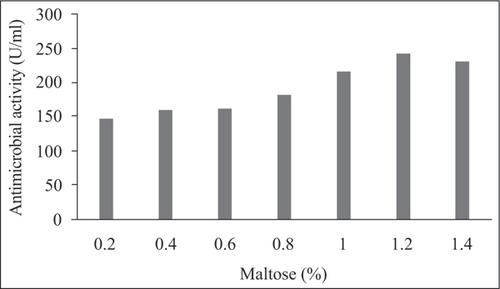Current Pharmaceutical Biotechnology ( IF 2.2 ) Pub Date : 2020-10-31 , DOI: 10.2174/1389201021666200622120850 Mohammed A Almalki 1

|
Background: Streptomyces sp. produces various antibiotic agents and the number of lead molecules from the genus Streptomyces increased rapidly in recent years. Drug resistance against various commercially available antibiotics is one of the important problems throughout the world. Streptomyces spp. produce various antimicrobials with potent activity against drug-resistant bacteria.
Methods: Streptomyces sp. SA1 was isolated from the marine environment for the biosynthesis of antibiotics. The important variables influencing secondary metabolite biosynthesis were optimized to increase the biosynthesis of antimicrobial agents using the traditional method and statistical approach.
Results: Streptomyces sp. SA1 produced novel antibiotics and the process variables were optimized by the traditional method (One-variable-at-a-time approach). Maltose showed maximum antimicrobial activity (220 U/mL). Analysis of the nitrogen, the effect of nitrogen sources revealed that beef extract incorporated culture medium showed rich antibacterial activity (188/mL). Among the ionic sources, KCl significantly influenced antibiotic production. Maltose, beef extract and KCl were considered as the most influencing medium components. Antimicrobial agent biosynthesis was achieved with maltose 1.22 g/L, beef extract 0.93 g/L and KCl 0.27 g/L in response surface methodology.
Conclusion: Actinomycetes, especially Streptomyces, play an important role as a source for bioactive compounds that are used to treat infections, and many other diseases. The isolated Streptomyces sp. was a good producer of antibacterial agent, which required various nutritional supplements in the culture medium. The optimized medium components investigated in this study will be useful for future studies with the mass production of secondary metabolites.
中文翻译:

新型链霉菌属次生代谢产物的体外筛选和生物合成。来自海洋环境的SA1。
背景:链霉菌。产生各种抗生素剂,并且链霉菌属中的前导分子的数量近年来迅速增加。对各种市售抗生素的耐药性是全世界的重要问题之一。链霉菌 产生对抗菌药物具有有效活性的各种抗菌药物。
方法:链霉菌 SA1是从海洋环境中分离出来的,用于抗生素的生物合成。使用传统方法和统计方法,优化了影响次生代谢产物生物合成的重要变量,以增加抗菌剂的生物合成。
结果:链霉菌 SA1产生了新型抗生素,并且通过传统方法(一次可变一次方法)对工艺变量进行了优化。麦芽糖显示出最大的抗菌活性(220 U / mL)。分析氮,氮源的作用表明掺入牛肉提取物的培养基显示出丰富的抗菌活性(188 / mL)。在离子源中,氯化钾显着影响抗生素的生产。麦芽糖,牛肉提取物和氯化钾被认为是影响最大的培养基成分。在响应面法中,麦芽糖1.22 g / L,牛肉提取物0.93 g / L和KCl 0.27 g / L实现了抗菌剂的生物合成。
结论:放线菌,尤其是链霉菌,作为用于治疗感染和许多其他疾病的生物活性化合物的来源发挥着重要作用。分离的链霉菌 是很好的抗菌剂生产商,需要在培养基中添加各种营养补充剂。在这项研究中研究的优化的培养基成分将对未来大规模代谢次级代谢产物的研究有用。











































 京公网安备 11010802027423号
京公网安备 11010802027423号